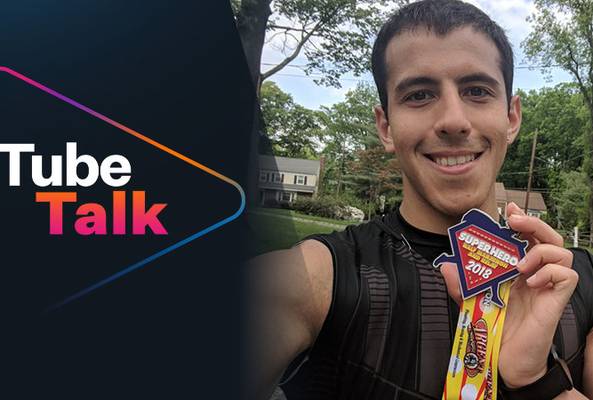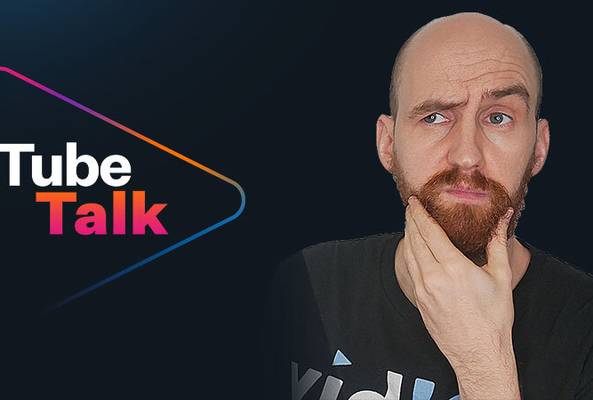Liron Segev, aka TheTechieGuy, is the Director of Customer Success at vidIQ, an internationally celebrated Digital YouTube Strategist working with some of the largest brands and YouTube influencers in the world. Over the past 20+ years, his work has taken him to South Africa, the UK and the US where he frequently speaks at conferences and provides expert tech commentary for various print publications, radio, and TV while actively running his Tech YouTube Channel.
The Five Principles of New YouTube Success: TubeTalk Episode 156
What is the secret to success on YouTube? On this episode of TubeTalk, the YouTuber podcast, we’ll discuss the five principles with our very special guest Scott Simson. Scott practices what he preaches and has used the five principles process to drive 300,000 subscribers, and 100 million organic views across his YouTube channels in just 18 months. If you want to know what these principles are and how you can apply this formula to your own channel click on the podcast link above.
As well as running a number of successful YouTube channels. Scott is also the owner of Raffiti Media and the CEO of Video Marketing World, a Texas based convention for video creators and marketers.
The Five Principles of Success on YouTube
For anyone creating content on YouTube with the aim of increasing views and subscribers, there are a number of programming and audience development strategies they need to be aware of. YouTube expert Scott takes us through five of the most important:
#1 Find Your Focus Then Stay in Your Lane
Scott highly recommends focusing in on a topic or category that you are most familiar with, or are at a specialist at, and go all out on creating and promoting content about that theme on YouTube. At one time, creators could publish videos around a broad topic (for instance - family vlogging) and upload a wide variety of content from different angles. But as YouTube continues to refine its algorithm with the aim of surfacing relevant, quality content to viewers, creators need a single focus. In other words, you have to do one thing really, really well in order for the algorithm to like you.
Scott learned this lesson through experience last year when views tanked on his general ‘family’ content. While many other family-focused vlogging channels diversified and incorporated wider trends in their programming strategy, Scott made the decision to refine exactly what they wanted to offer their audience and double down, and triple down on content that has driven huge views and engagement. It’s a strategy that’s worked.
For any creator who is just starting out, Scott recommends that until you have established a base audience of people who are watching you, stick with one thing. Once you get into the hundreds of thousands, or even millions of subscribers and your daily views are in the hundreds of thousands or millions, then you can start to branch a little bit and do more of a variety because you have a core community of people that's large enough that will follow you wherever you go, whatever you do. At the beginning, the safest thing to do is to carve out your little niche on YouTube and focus exclusively on that for a good long while.
#2 Diversify Your Income from Video - Now
There was a time when you could predict your income from YouTube based off what you made in the previous year. Those days are long gone. Now, income can fluctuate month to month so YouTubers need to diversify where your income is coming in from. For Scott, that means not being reliant on Adsense income but looking at many other monetization opportunities including brand deals, product sales, affiliate links, lead generation etc. He advises any other creator looking to earn a passive income (or a more substantial income) to do the same.
Think of a product that you can sell and sell it from the beginning. Try and talk to brands early. Most companies now understand the power of influence on marketing, and so they're willing to deal with micro influencers, whether it be with product sales or with affiliate type of program or with just product trade for video time. Most brands now realize that's the power of YouTube and social video.
If you sell a product or service obviously your YouTube Channel is a great vehicle for sales or lead generation. Or, if there is a way to create a physical product around your channel (like an ebook) then that’s an opportunity for you to monetize too. Alternatively, you can leverage your subscriber base via affiliate marketing - essentially making money from that by linking out to something like an Amazon website or the company site that sells a product or service you promote. Every time somebody clicks on that link and buys something, you'll get a small commission. Scott does this and generates passive income across his YouTube Channels. As long as the creator discloses that affiliate links are being used via their terms and conditions, and in their ‘About’ section, an affiliate is a good way for pretty much every single niche Scott can think of.
*(Note: If you love vidIQ then consider becoming an affiliate - check out the details here.) *
#3 Understand Your Audience Purchase Power
Even more important than understanding your audience purchase power is to develop your audience purchase power. Just because you have a certain number of YouTube subscribers, doesn’t mean they will follow your lead and click through on those affiliate links. But if you are successful at promoting a product or service you can track activity on those affiliate links, and establish your purchasing power and your authority. That’s the kind of data you can then use to entice a brand as part of a deal. You can confirm you have an average of so many clicks and so many purchases made of the products you have promoted on your channel, and how much you will charge a brand based off that.
The best way to build purchase power is by promoting things that you are 100% passionate about. If you just take every crazy brand deal that comes your way then your purchasing power is going to be minuscule because people don't want the junk that you're pushing on them. But if you're promoting XYZ camera that has been amazing and these are the 15 reasons that I love it, then you're going to have more people who are going to want to purchase that camera based off of your testimonial or your review. Understanding and developing purchase power is massive.
#4 Play the Long Game on YouTube
YouTube is a marathon, not a sprint. Creators have to be prepared to be in it for the long haul, if they want to be massively successful. You can’t just throw one video up and then ask "Why aren't people watching?" because the YouTube algorithm doesn't work that way. You have to put in the leg work and you've got to do all of the right optimization things on the backend, like creating an awesome custom thumbnail and optimizing your keywords. It may be a few weeks before you start to pick up any traffic from the algorithm.
Creating just a few videos thinking you are going to become YouTube famous is not the case any more (unless you're bringing a massive audience over from Instagram, or Snapchat or TikTok). You've got to put in the time. There's no instant success anymore. Those very, very, very, very few channels that will blow up massively, they either making amazing content that nobody's ever seen before or they've got access to something nobody else has.
#5 Become an Important Part of Your Online Community
The fifth principle is about the importance of actually being part of a community, something Scott didn’t appreciate at the beginning of his creator journey. But as soon as he started to take it seriously he started to meet others in the family blogging community and build relationships with them, including collabs. He started to pick up tips about content creation and other aspects of being a vlogger. When you surround yourself with people that are doing the exact same thing that you are doing, you cut learning curves down because you learn from everybody else's mistakes and everybody else's wisdom at the same time. You get this masterclass just by hanging out with people that you are in the same boat with. And that's why it's super important to be part of your community, and attend video marketing and other similar events.
Also, jump onto online communities, like the thousands of YouTube groups there are on Facebook. There are things that are happening all the time where you can kind of build a little communities, sub-communities of creators. There are so many different ways that you can put yourself out there at different levels and get back what you're looking for.
vidIQ would like to say a HUGE thanks to Scott Simson for his time and his invaluable wisdom. Please subscribe to his YouTube Channel or follow him on Twitter. This has been TubeTalk episode 156 - tune in next week for the next for more help and advice for all things YouTube.
Subscribe to TubeTalk: The Video Marketing Podcast!
TubeTalk has been informing video creators amd marketers since 2014, and is one of the most respected and listened to podcasts in the online video industry. Subscribe today so you never miss an episode! You can find vidIQ's TubeTalk at:
Want To Get More Views on YouTube?
If you want to take your YouTube channel to the next level then make sure to download vidIQ. It will help you research YouTube, analyze videos, audit your own channel, and take actionable steps click here to install now!



